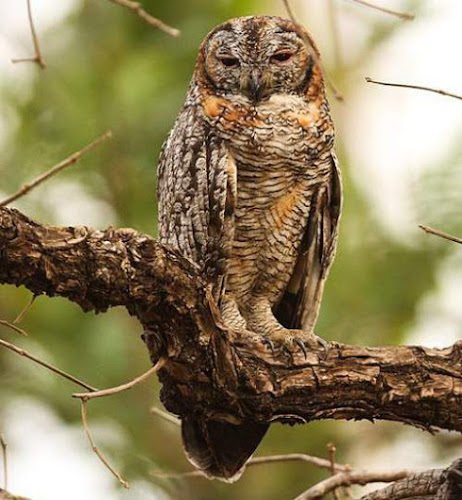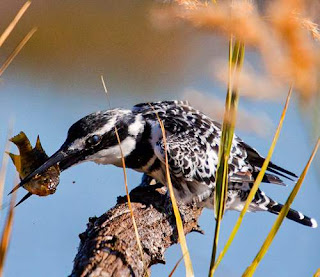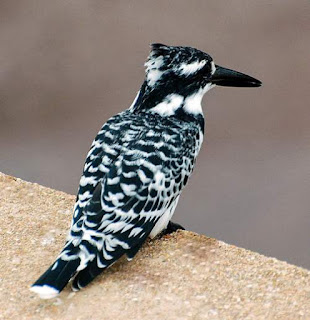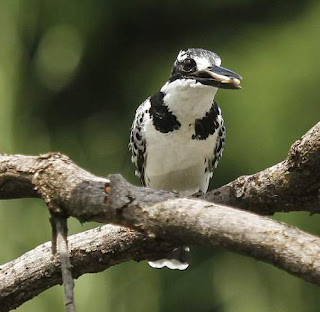Indian birds ›
Narcondam hornbill ›
Pied kingfisher - Ceryle rudis
The pied kingfisher (
Ceryle rudis) is a water kingfisher belonging to the family, Alcedinidae.
The pied kingfisher species are widely distributed across Indian subcontinent, Africa and Asia. These kingfisher species are the only member of the genus
Ceryle. There are four recognized subspecies of these kingfishers.
Appearance, physical description and identification
The pied kingfisher (
Ceryle rudis) is a medium-sized kingfisher, measuring 25 to 26 cm in length and weighing 70 to 110 grams.
These pied kingfishers have distinctive black and white plumage. The crown and the crest are black. The upperparts are barred in black. The male birds have a black double band across the breast whereas the females have a single band broken at the middle of the breast.
In these kingfishers, the lower breast and the rest of the underparts are white. There is a white stripe (supercilium) running from the base of the beak above the eye, finishing towards the rear of the crest. The tip of the black banded tail is white.
The kingfisher bill is black. The irises are black. The feet are black. Their call is a loud “kwik-kwik” or a sharp "chirruk-chirruk" sound.
 |
| Birds of India - Image of Pied kingfisher - Ceryle rudis by Hans Hillewaert |
 |
| Indian birds - Picture of Pied kingfisher - Ceryle rudis by Hein waschefort |
 |
| Birds of India - Photo of Pied kingfisher - Ceryle rudis by Harvey Barrison |
Origin, geographical range and distribution
These pied kingfisher species are widely distributed in Africa and Asia. They are distributed in Indian subcontinent, Africa, Middle East, southern China and northern part of southeast Asia.
The pied kingfisher subspecies
C. r. leucomelanurus are distributed in Afghanistan, Pakistan, India, Nepal, Bhutan, Bangladesh, Sri Lanka, Myanmar, Thailand, Cambodia, Laos and Vietnam. The kingfisher subspecies
C. r. travancoreensis is distributed in southwest India.
In China, the pied kingfisher subspecies
C. r. insignis are distributed in the provinces of Sichuan, Yunnan, Guizhou, Hubei, Hunan, Guangxi, Hainan, Guangdong, Jiangxi, Fujian, Anhui, Jiangsu and Zhejiang.
In the Middle East, the pied kingfisher subspecies
C. r. rudis are distributed in Iran, Iraq, Syria, Turkey, Lebanon, Israel and Jordan.
In Africa, the pied kingfisher subspecies
C. r. rudis is distributed in Egypt, Sudan, Eritrea, Ethiopia, Somalia, South Sudan, Uganda, Kenya, DR Congo, Chad, Central African Republic, Cameroon, Nigeria, Benin, Togo, Mali, Ivory Coast, Ghana, Liberia, Sierra Leone, Burkina Faso, Guinea, Gambia, Senegal, Mauritania, Guinea-Bissau, Equatorial Guinea, Republic of the Congo, Gabon, Tanzania, Rwanda, Burundi, Angola, Zambia, Malawi, Mozambique, Zimbabwe, Namibia, Botswana, South Africa and Swaziland.
The Important Bird and Biodiversity Area (IBA) of these kingfisher species in Turkey are Southern Euphrates Valley, Birecik Plains, Dicle Valley, Karkamış, Cizre and Silopi.
Ecosystem and habitat
These pied kingfisher species have low forest dependency. These species occur in altitudes from 0 to 2500 meters.
The artificial ecosystems of these pied kingfisher species include, water logged excavations, flooded, irrigated lands, irrigational canals, dams, reservoirs, water storage ponds and lakes.
The natural ecosystems of these pied kingfisher species include tropical and subtropical mangrove vegetation, wetlands, flooded grasslands, freshwater lakes, marshes, marine lagoons, rocky, sandy and gravel shoreline, macroalgae covered seas, estuaries, rivers, streams and creeks.
Diet and feeding behavior
The diet of these pied kingfisher species is mostly fish. Crustaceans, fish, amphibians and aquatic insects are their primary food. These birds hunt from perches near water. Diving into the water, they catch the prey with bill.
These pied kingfishers also hover over the water before diving for the prey. Smaller prey is swallowed on the wing. Larger prey is brought to the perch and bashed repeatedly till it is immobile and then swallowed whole.
Reproduction and breeding habits
The breeding season of these pied kingfisher species is from February to April in northern India. The breeding season is during August and September in Middle East. The laying season is from March to June in Jammu and Kashmir (India) and northern Pakistan.
These pied kingfisher species are monogamous. There is initial courtship before mating. There may be colonial breeding. The family group may function as primary helpers or secondary helpers.
The pied kingfisher nesting sites are located in vertical mud banks and sometimes in flat grassy ground. The nesting tunnel of about 1.25 meters long is excavated by the breeding pair. The tunnel ends in the unlined incubating chamber. The typical kingfisher clutch contains four to five oval white eggs.
Migration and movement patterns
The pied kingfisher species are non-migratory resident birds.
Post breeding, the juvenile kingfishers may disperse and establish in new locations within the range. They may make local movements for feeding and breeding within their range.
Pied kingfisher - Overview
-
Scientific name: Ceryle rudis
-
Species author: (Linnaeus, 1758)
-
Synonyms/Protonym: Alcedo rudis Linnaeus, 1758
-
Family: Alcedinidae › Coraciiformes › Aves › Chordata › Animalia
-
Vernacular names: English: Pied kingfisher, Chinese: 斑鱼狗, French: Martin-pêcheur pie, German: Graufischer, Spanish: Martín pescador pío, Russian: Малый зимородок, Japanese: ヒメヤマセミ, Tamil: Karuppu Vellai Meenkothi
-
Other names: Lesser Pied Kingfisher
-
Distribution: Indian subcontinent, southeast Asia, southern China, Africa, Middle East
-
Diet and feeding habits: fish, crustaceans, mollusks, aquatic insects
-
IUCN status listing: Least Concern (LC)
The four recognized subspecies of pied kingfisher (
Ceryle rudis) are:
Ceryle rudis rudis (Linnaeus, 1758),
Ceryle rudis leucomelanurus Reichenbach, 1851,
Ceryle rudis travancoreensis Whistler, 1935 and
Ceryle rudis insignis E. J. O. Hartert, 1910.
Conservation and survival
The global population size of the pied kingfisher (
Ceryle rudis) has not been quantified. The overall population trend of these kingfisher species is not known. Throughout its range it is reported to be common and widespread. The generation length is 4.4 years. Its distribution size is about 69,300,000 sq.km.
The pied kingfisher (
Ceryle rudis) does not approach the thresholds for being Vulnerable, either under the range size criterion, or under the population trend criterion, or under the population size criterion. The ongoing habitat destruction and use of poisons to kill fish are the main threats that may endanger the survival of these kingfisher species.
IUCN and CITES status
The IUCN (International Union for Conservation of Nature) has categorized and evaluated the kingfisher species and has listed it as of "Least Concern". The CITES (Convention on International Trade in Endangered Species of Wild Fauna and Flora) status is ‘Not Evaluated’ for the pied kingfisher (
Ceryle rudis).
|
Taxonomy and scientific classification of Ceryle rudis |
|---|
|
Kingdom: | Animalia |
|
Phylum: | Chordata |
|
Class: | Aves |
|
Order: | Coraciiformes |
|
Family: | Alcedinidae |
|
Subfamily: | Cerylinae |
|
Genus: | Ceryle |
|
Species: | C. rudis |
|
Binomial name: | Ceryle rudis |
|
IUCN status listing: |

Least Concern
|
1.Image source: https://commons.wikimedia.org/wiki/File:Ceryle_rudis_(male).jpg (cropped)
Image author: Hans Hillewaert | License:
CC BY-SA 3.0
2.Image source: https://commons.wikimedia.org/wiki/File:Pied_kingfisher_killing_fish.jpg (cropped)
Image author: Hein waschefort | License:
CC BY-SA 3.0
3.Image source: https://commons.wikimedia.org/wiki/File:Ceryle_rudis_-Kruger_National_Park,_South_Africa-8_(2).jpg (cropped)
Image author: Harvey Barrison | License:
CC BY-SA 2.0 as on 5/26/17
Current topic in Birds of India: Pied kingfisher -
Ceryle rudis.
























